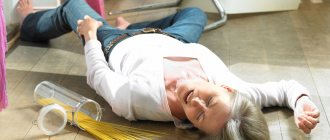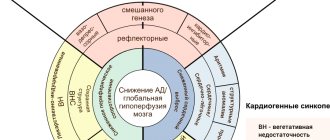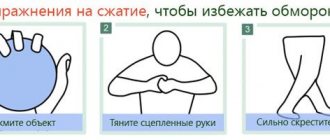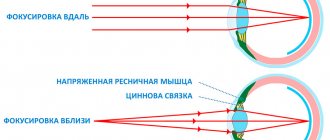Syncope or fainting is an attack of sudden, short-term loss of consciousness that occurs due to a short-term disruption of blood flow in the brain. The duration of fainting lasts from 15-30 seconds to 3-5 minutes. Most often, a person comes to his senses on his own after a short period of time. Syncope is not considered a disease, but can be an important symptom of serious medical conditions. When providing first aid, you need to recognize the usual fainting state from an epileptic seizure.
What is syncope?
Fainting is most often a symptom of a primary disease. Pathological conditions accompanied by syncope include: diseases that arise due to low (small) cardiac output syndrome (aortic stenosis, ischemia, bradycardia, myocardial infarction, angina pectoris, tachycardia, cardiac dysfunction, pulmonary stenosis, cardiac arrhythmia); ailments arising from a lack of oxygen in the blood plasma (anemia, hypoxia); conditions that are accompanied by a violation of the nervous regulation of blood vessels (fainting when quickly getting out of bed or swallowing food).
Many reasons can lead to a short-term “shutdown” of the functions of the heart and blood vessels, which are regulated by the autonomic nervous system. When you faint, there is a short-term decrease in the number of heart contractions, and blood pressure also decreases. With simultaneous and very strong expansion of the veins, the required amount of blood stops flowing to the heart, as a result of which the brain lacks oxygen. Under the influence of many factors and processes occurring in the body, a person falls in syncope.
Content:
- What is syncope?
- Causes of syncope
- Signs and symptoms of fainting
- The essence of emergency care for fainting
- Distinguishing features of syncope from coma
- Which specialist should I contact after fainting?
Fainting. We bring you to your senses
According to fiction, in the 18th and 19th centuries, ladies and girls of noble birth constantly fainted because of corsets and sensitive upbringing. Today, barbaric corsets and delicate manners are a thing of the past, but fainting still happens contemporaries Why does this happen and what to do in such cases?
The brain seems to shut down
Fainting is a brief, sudden loss of consciousness that can occur for a variety of reasons. Fainting itself, strictly speaking, is not a disease. Modern medicine calls it syncope (from the Greek word “syncope” - “chopping off”). By the way, this term literally corresponds to the colloquial expression "passed out" or "passed out" when talking about a person who has suddenly lost consciousness. The mechanism of fainting is simple. Human respiratory activity is regulated by a homeostasis system, which ensures a normal supply of oxygen to all organs and systems. But sometimes this system fails and the brain does not receive enough oxygen. This is why fainting happens - the brain seems to turn off.
Causes of syncope
The cause of fainting can be strong nervous feelings, fright, fear, or severe pain. These conditions lead to an immediate decrease in pressure in the arteries, which reduces blood flow, disrupts the blood supply to the brain and causes fainting. If a person eats irrationally, sits on constant exhausting diets, often engages in strenuous sports, lacks sleep, feels weak, and is nervous, in these cases blood pressure also drops sharply and syncope is observed.
A person may become ill while staying in a room with little fresh air. For example, if ventilation is not working properly and there are no hoods, there is a high probability of fainting. Also, when cooking food in the kitchen for a long time or staying in a room where there are a large number of people, you can easily lose consciousness and require immediate first aid from others.
If you stand for a long time, for example at a school assembly or meeting, there is a risk of fainting. If a person stands motionless, blood stagnates in the lower extremities, as a result of which the amount of blood flowing to the brain decreases and syncope is difficult to avoid. Other causes of fainting include: hysteria; metabolic disorder; influence of drugs.
Kinds
Fainting (syncope) conditions can be divided into two most common forms (types) of fainting:
- Neurogenic – based on a reflex decrease in postural vascular tone;
- Fainting associated with diseases of the heart and large (main) vessels.
Neurogenic syncope
The most common form of fainting, which is based on a reflex decrease in peripheral vascular tone in response to environmental factors. The development of fainting is preceded by a short period. A few seconds or minutes before loss of consciousness, there is a feeling of discomfort, weakness in the legs, nausea, yawning, ringing in the ears, darkening in the eyes. Following this, the person falls or slowly sinks to the floor. Most of these fainting episodes are characterized by a rapid and complete recovery of consciousness and satisfactory well-being after the attack.
This group of fainting includes:
- Vasodepressor - most often occurs in young people in response to certain factors - pain, fear, fasting, emotional stress, the sight of blood, stuffiness, tooth extraction, sudden messages about pleasant or unpleasant things. This is the most common type of fainting and does not pose a serious threat to health or life.
- Orthostatic – occurs when there is a sudden change in body position from horizontal to vertical. In the mechanism of occurrence of this condition, a violation of autonomic neuroregulation plays an important role. When carefully examining such patients, doctors note constant complaints of feeling tired in the morning, decreased performance, constant headaches and dizziness. Orthostatic fainting can occur during the recovery period after a cold, during prolonged bed rest, in the postoperative period, as well as when certain medications (neuroleptics, antidepressants) are taken incorrectly.
- Vestibular – more often observed in children and adolescents with increased excitability of the vestibular apparatus. Occurs during a boat trip or a long stay on a swing. Fainting occurs suddenly, consciousness is restored quite quickly.
- This group also includes fainting that occurs with increased sensitivity of the carotid sinus, with irritation of the branches of the vagus nerve. In this case, there is a sharp decrease in heart rate, a decrease in blood pressure and, as a consequence, secondary insufficiency of blood supply to the brain. Such fainting is more often observed in older people, with sudden turns of the head, pressure with a pillow during sleep, or when wearing tight collars or ties.
- Situational fainting - can occur with prolonged coughing, defecation, urination, prolonged stay in the mountains, during sports, in particular when lifting weights.
Fainting associated with diseases of the cardiovascular system
Usually occur suddenly, without warning.
They are divided into two main groups:
- Fainting associated with disturbances in heart rhythm and conduction. Episodes of paroxysmal tachycardia deserve special attention.
- Fainting due to decreased cardiac output (aortic stenosis, myocardiopathy, myocardial infarction, dissecting aortic aneurysm).
All these diseases require treatment in a hospital setting under the supervision of a doctor.
Fainting can also develop with severe infectious diseases, such as toxic flu, viral hepatitis, acute dysentery, typhoid and typhus.
On this topic ▼
Heart attack (infarction)
Symptoms and first aid
As we have already said, isolated episodes of fainting are, in essence, not life-threatening. But there are reasons for alarm if you faint:
- Is a consequence of any disease of the heart and blood vessels;
- Accompanied by head trauma;
- Repeats regularly and at short intervals;
- It happens in older people when they are in full health;
- Accompanied by the disappearance of all swallowing and breathing reflexes.
In most cases, the diagnosis can be established based on a detailed interview with the patient, physical examination and ECG recording. In some cases, positional tests are performed, sometimes against the background of drug therapy.
In the presence of heart disease: Holter monitoring, ECG, CT or MRI of the brain, angiography.
The first aid poster is available by clicking the Download button after the article!
Signs and symptoms of fainting
Syncope is a condition that indicates a lack of oxygen and the possible presence of a disease in the human body. Fainting becomes a wake-up call to visit specialists with medical education, undergo a full diagnosis and take the necessary tests.
The main signs and symptoms of syncope are:
- shallow, barely audible breathing;
- rare and weak pulse;
- brief absence of consciousness.
If a person has lost consciousness for a short time, he should be placed on a couch or bed in a horizontal position and the lower limbs should be slightly elevated. If the victim feels significantly better after 15-30 minutes, then it was fainting.
Fainting is also characterized by: noise in the organ of hearing; severe weakness; dizziness; nausea; the appearance of cold sweat; numbness of the legs; the appearance of a veil in front of the organ of vision.
The essence of emergency care for fainting
If a person does not have breathing problems (open airways are observed, the pulse is palpable, there is no shortness of breath), he should be placed in a horizontal position on his back and his legs raised. First aid for fainting is that the victim needs to unbutton or remove outer clothing that is constricting and restricting breathing (blouse, shirt, collar, belt).
To improve blood supply to the brain and constrict blood vessels, it is advisable to wipe the skin of the face and neck with a towel dipped in cold water. A cloth soaked in cold water should be wrung out and applied to the forehead.
If the victim is vomiting, he should be placed in a comfortable position and his head turned to the side to eliminate the possibility of choking on vomit. Fainting lasts several minutes, but if a person does not regain consciousness after a maximum of 10 minutes, cotton wool should be moistened with ammonia and held at a distance of 5-7 cm from the nose for several seconds. If this manipulation is ineffective, this is no longer a fainting state, but a prolonged loss of consciousness. People around you need to call an ambulance or take the person in syncope to the nearest emergency room.
If the victim does wake up, he needs to drink a cup of hot herbal tea, and only then sit down or get out of bed for a while. It will take from 15 to 60 minutes to restore strength. You shouldn’t force a person to get up and go somewhere; let him lie down and rest. After a short period of fainting, you need to see a doctor and get examined.
When to call an ambulance if you faint
Dial 103 immediately if an unconscious person exhibits any of the following Fainting Treatment symptoms:
- fainting lasts longer than a minute;
- the victim has blue lips and face;
- it seems to you that the victim is not breathing and/or has a pulse;
- the person has regained consciousness, but complains of an irregular or too slow heartbeat;
- there are complaints of chest pain and difficulty breathing;
- after fainting, a person falls asleep, it is difficult to wake him up;
- during or after fainting, seizures, convulsions are observed, the person makes uncontrolled movements;
- the victim has regained consciousness, but complains of blurred vision, difficulty speaking, and confusion;
- a person was injured in a fall or you have reason to suspect it.
Do not under any circumstances hope that any of these signs will go away on their own. These symptoms indicate that the heart is not working properly. If help is not provided in time, the matter may end in death.
Distinguishing features of syncope from coma
Syncope is a short-term state and is accompanied by short-term memory loss and decreased muscle tone. When you faint, breathing, swallowing and other protective reflexes do not disappear, so there is no danger of suffocation (asphyxia).
Best materials of the month
- Coronaviruses: SARS-CoV-2 (COVID-19)
- Antibiotics for the prevention and treatment of COVID-19: how effective are they?
- The most common "office" diseases
- Does vodka kill coronavirus?
- How to stay alive on our roads?
During a coma, the muscles relax and the tongue sinks, as a result of which the airways are clogged, therefore, there is a possibility of suffocation. Fainting quite often develops into a coma, which is a serious danger to human life. This transition is possible due to a sharp fall and a blow to the back of the head. Due to severe bruising, there is a risk of seizures, which are a symptom of normalization of blood circulation in the brain. The most important thing is not to confuse seizures with an epileptic attack.











